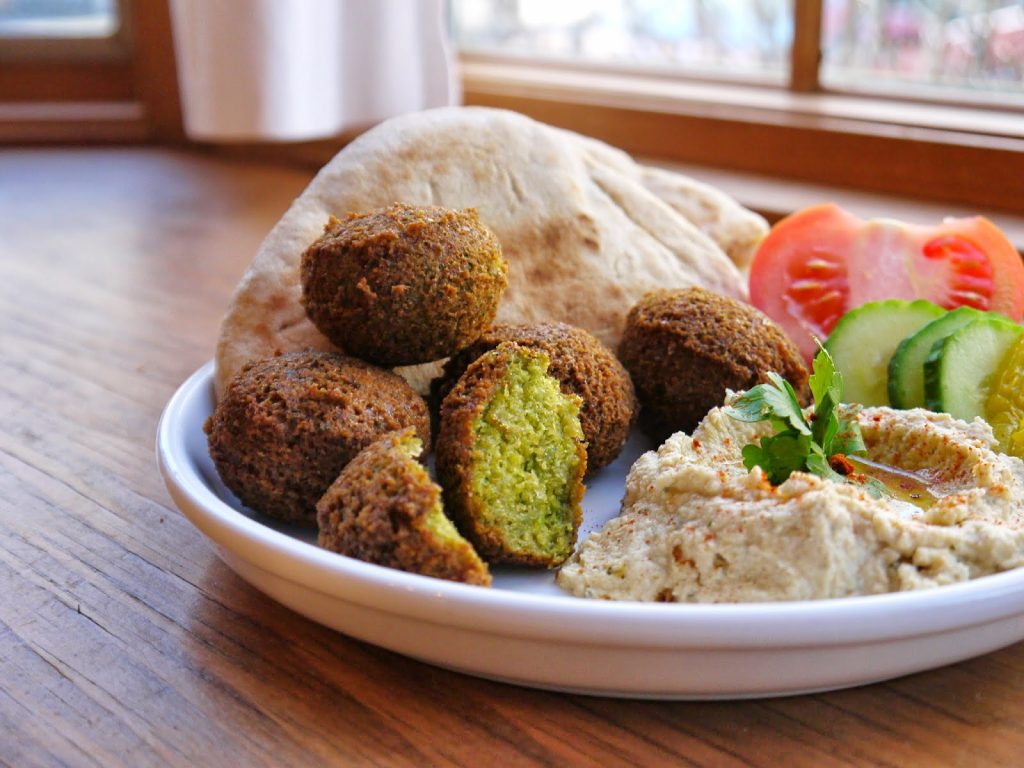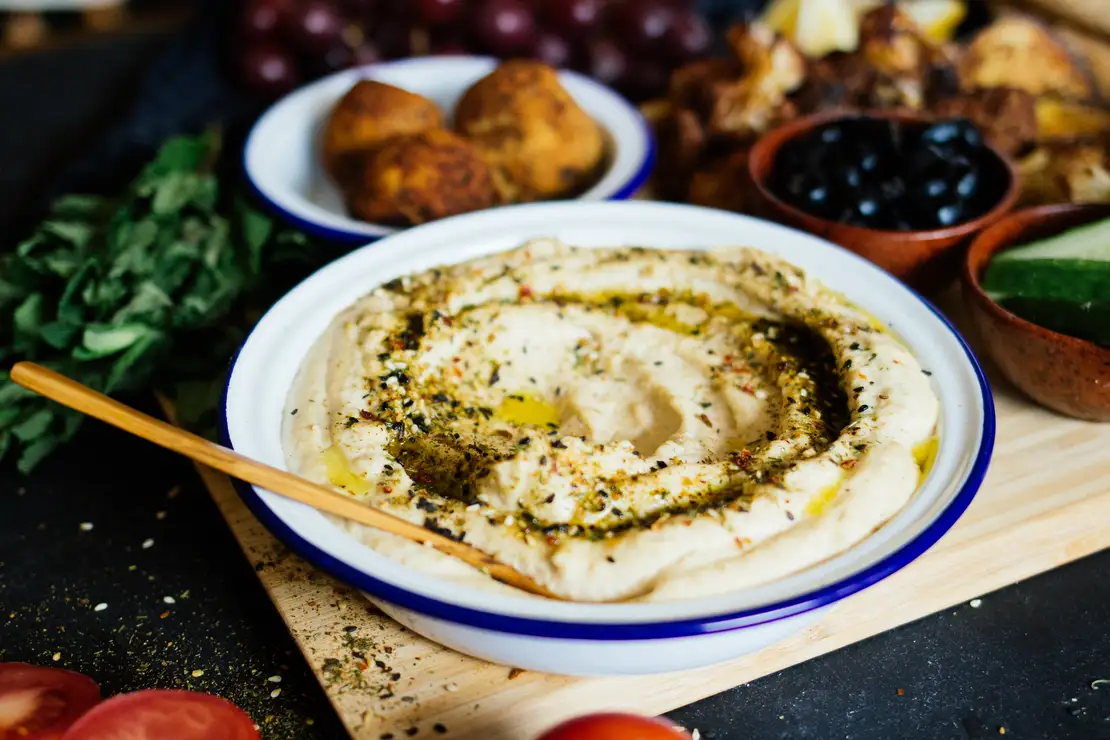I love Arabic food. One of the reasons could be that I was born in Kreuzberg and grew up with lots of different foods from all over the world. And still today, I love to visit all the Arabic restaurants in Kreuzberg and Neukölln together with my friends. Another reason could be that I am visiting a Syrian family every week and therefore get to know a lot of Arabic dishes like this vegan mujaddara, I love, love, love! And even though the selection of Arabic dishes is very diverse, most people think of hummus and falafel first. And even though there are a lot of damn good dishes, I could eat falafel and hummus every day.
So I had a look at the different ways of preparing hummus and falafel and developed recipes that you can easily cook at home. However, I would like to mention first: There are countless ways to prepare hummus and falafel, and sometimes it seems to be a science, cause every chef, restaurant, website, and region prays to have the only and best original recipe. So I just prepared the food the way I like them best, ha! Although hummus and falafel play the main role, we also prepared a fresh tabbouleh (parsley salad) and makali (fried vegetables) and added some olives, tomatoes, cucumbers, and Arabic bread. A beautiful buffet to share with your friends!
For the hummus, there are different ways of preparing the chickpeas. We recommend taking dried chickpeas and soaking them overnight. However, we also added a version for canned chickpeas. For the falafel balls, we would definitely recommend using dried chickpeas and soaking them in water overnight. Chickpeas in cans are boiled – but for falafel, you only need soaked chickpeas. This makes a big difference in the consistency!
Vegan hummus platter with falafel, tabbouleh & makali
Ingredients
hummus
- 350 g dried chickpeas or 700 g tinned chickpeas
- 1 tsp baking soda
- 2 cloves of garlic
- 400 g tahini
- 1.5 lemons
- 1.5 tsp cumin
- 1.5 tsp salt
- olive oil
- hummus topping (e.g., from Just Spices)
tabouleh
- 50 g bulgur
- 100 g fresh parsley
- 10 g fresh mint
- 150 g tomatoes
- 2 spring onion
- 2 lemons
- 70 ml olive oil
- salt
falafel
- 250 g dried chickpeas or 500 g tinned chickpeas
- 5 cloves of garlic
- 20 g fresh parsley
- 2 tsp coriander
- 2 tsp cumin
- 1 tsp baking powder
- salt
- 0.5 l vegetable oil (rapeseed or sunflower oil)
- as required: chickpea flour

makali
- 1 small head of cauliflower
- 1 eggplant
- 1-2 tsp salt
- 100 g cornstarch
- 0.5 l vegetable oil (rapeseed or sunflower oil)
additional
- 2 fresh lemons
- 4-5 lettuce leaves (Romana)
- Arabic bread
Instructions
Prepare chickpeas
Falafel
- Wash the dried chickpeas thoroughly and soak them in cold water overnight.
hummus variant 1: dried chick peas
- Wash the dried chickpeas thoroughly and soak them in cold water overnight.
- The next day, remove the chickpeas from the water. Place chickpeas in a pot, add water and baking soda, and let simmer for 30-60 minutes (depending on the consistency of the chickpeas). In the end, the chickpeas should be very soft.
- Remove the chickpeas from the stove and let the chickpeas cool down until they are lukewarm. Save the cooking water!
hummus variant 2: canned chickpeas
- Place the canned chickpeas with the liquid (from the can) and the baking soda in a pot and let simmer for about 20-30 minutes on medium heat. Add water if necessary.
- In the end, the chickpeas should fall apart slightly and be nice and soft. Save the cooking water and let chickpeas cool down until they are lukewarm.
Preparing the hummus
- Squeeze the juice of the lemons and add it to a blender.
- Peel the garlic cloves and also add them with the tahini, cumin, and salt. Turn on the food processor and let it run for a minute or so.
- Now add the chickpeas and mix again. Add the cooking water until you get a creamy, fluffy hummus. At the end season again if necessary.
- Serve the hummus with olive oil on top and hummus topping.
Tabouleh
- Prepare the bulgur according to the instructions on the package. Drain well afterward.
- Wash the parsley and mint and chop both finely. Wash and chop the tomatoes and spring onion as well.
- Squeeze the juice of the lemons. Mix dressing with olive oil and salt.
- Mix all ingredients in a bowl and season to taste.
Falafel
- Drain the chickpeas in a sieve and put them twice in a meatgrinder. Alternatively, put the chickpeas in a food blender. The chickpea mixture should still be quite coarse at the end and not mashed.
- Peel the garlic and onion and chop finely.
- mix the chickpeas with the onion, garlic, and the spices in a bowl and let it rest in the fridge for at least 1 hour. Then add the baking powder and form 10-12 balls from the mixture.
- Heat the vegetable oil in a pot. You can place a wooden skewer in the oil – if bubbles form around the skewer, the oil is hot enough.
- Deep-fry the falafel for about 5 minutes until they are crispy brown. The falafels should come to the surface very quickly. Drain the balls on a cloth afterward.
Tip
Sometimes it happens that the falafel balls are falling apart during the deep-frying process. Most of the time, it’s because they are mashed and too wet inside. You can try to improve this by adding some chickpea flour so that the falafel dough becomes drier. A second reason could be that the oil is not hot enough.
Makali
- Wash the eggplant, remove the ends and cut into 0.5 cm thick slices.
- Place the slices on a paper towel, sprinkle with salt and after 5 minutes, turn them over and proceed in the same way for the second side. This way, we remove the water from the eggplant slices before deep-frying them. Remove the leaking water with a paper towel.
- Wash the cauliflower, dab dry, and cut into florets.
- Place cornstarch in a pasta plate or bowl and add the cauliflower florets and the eggplant slices. Make sure all of the veggies are covered well in cornstarch.
- Heat the vegetable oil in a pot. To test, you can again hold a wooden skewer in the hot fat – if bubbles form around the skewer, the oil is hot enough.
- Fry the vegetables until crispy brown, and place them on a paper towel afterward.


Leave feedback about this